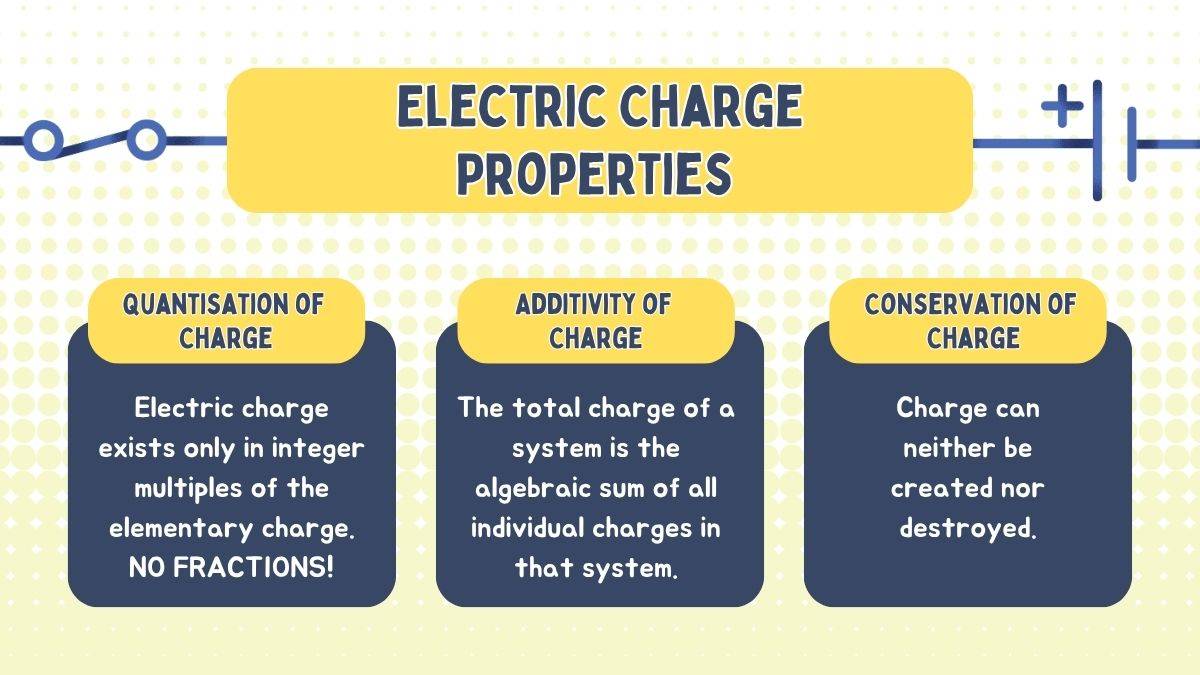
Explore the three properties of electric charge, which are additivity, quantisation, and conservation. This article will clear up any hurdle you may have in describing the principles of how electric charge behaves.
At this point in Class 12 Physics, we should not confuse the nature of charge that identifies whether it is positive or negative with the basic properties of charge.
Charge, by itself, exists because particles like electrons interact through forces of attraction (+) or repulsion (-) when placed in an electric field. Electric charge properties, however, show us the so-called rules. These govern how charge combines, is measured, and remains constant when electrons transfer across different substances like conductors and insulators.
What You’ll Learn in Properties of Electric Charge Class 12
- Learn why you cannot ever find a charge in fractions, much like it’s impossible to isolate half an electron’s worth of charge.
- Explore why charges must always exist in equal but opposite amounts.
- Find out how it is possible to calculate electrons before and after in exact amounts.
- Properties of Charges Class 12: Quick Summary
- Quantisation of Charge
- Conservation of Charge
- Additivity of Charge
- What Will Exams Test You on the Basic Properties of Electric Charge Class 12?
- Complete Study Material for Class 12
Properties of Charges Class 12: Quick Summary
The table below will be ideal when revising NCERT class 12 physics for the first chapter on the topic of charge properties.
| Property |
What It Means |
Basic Example |
| Quantisation of Charge |
Charge will only or always have discrete packets, appearing as integer multiples or real numbers of the elementary charge, when using the charge formula: q = n×e. There can never be any fractions of charge. |
An object can have 1, 2, or 1000 electrons, but never 1.5 electrons. Nature deals only in whole numbers. |
| Additivity of Charge |
The total charge in a system is the sum of all individual charges in a system. Summation is algebraic here. |
Q_total = q_1 + q_2 + q_3 + ... + q_n |
| Conservation of Charge |
The total charge in an isolated system is always constant. We cannot ever create a charge or even destroy it. But we can transfer it from one point to another. |
When two bodies exchange charge, the sum before will be equal to the sum after. |
Quantisation of Charge
Section 1.4.3 in the NCERT Class 12 Physics book highlights the “fact that electric charge is always an integral multiple of e is termed as quantisation of charge.”
That means that the total electric charge (q) on any object will only be able to exist as whole numbers, or more precisely, in integer multiples of the elementary charge (e).
Mathematically, we can express it as
q = ne
n is an integer (0,1,2, and so on)
e is 1.602×10^-19 C, and it’s also the charge of one single electron. That’s the base unit of charge, which you might refer to in Units and measurements class 11 notes or chapter.
That means, all possible values of electric charge would be 0e, 1e, 2e, and so on. They could also have negative counterparts, depending on the polarity of charges. Like -1e or - 2e.
If you ask why this quantisation of charge is there in discrete units, it’s because all matter with electrons, protons, and neutrons will have one elementary charge. There can never actually be half an electron. So the charge will only have discrete values. It’s not physically quantifiable to be 1.5e or 7.4e at the microscopic level.
So the main idea for quantisation of charge at the microscopic level is to remember.
- e is too tiny (1.602×10^-19 C)
- n is a whole number
But there is another aspect when quantisation is not used strictly. That is, when calculating large scale charges on everyday objects, ie, at the macroscopic level.
Quantisation of Charge: When Can You Ignore It?
At the macroscopic level, the elementary charge unit is way too tiny when you compare it with everyday charges.
Or the other way around, the total charge (q) becomes extremely large when compared to a single electron charge.
Just think about this comparison. 1μC=10^−6 C. That itself is 6.25×10^12 electrons.
It’s much like looking at a sandy beach from a distance. You know it’s made up of grains but from afar, it has a smooth, continuous surface.
So, in practical calculations for your NCERT Exemplar Class 12 Physics Chapter 1 exercises, you will come across some tricky problems. You have to figure when to or not to consider quantisation of charge.
Conservation of Charge
There is a law of conservation of charge that applies to isolated systems. The total or net electric charge (q) is constant with respect to time. It tells that it is impossible to create a charge and even destroy it. Electrical charge can only be transferred because it never changes.
Major Misconception on the Law of Conservation of Charge
A common mistake for some students while learning this conservation property of charge is thinking that the total charge sum is zero.
If you’re having this same doubt, too, you must overcome this by considering that the charge can be transferred from one body to another.
Take the example of an object A that gains electrons from another object B upon rubbing or contact. Object A is negatively charged. Object B becomes positively charged. What that means is the total charge (q) remains unchanged even after rubbing. Not necessarily zero.
So when you have to calculate charge transfer, you must look at the net charge before and after the transfer. They must be equal.
Q_before = Q_after
or, better put,
Additivity of Charge
As a scalar quantity, electric charge just has magnitude and sign. To calculate the total charge of the system that has multiple point charges (q_1, q_2, q_3, and so on), you just have to sum them using algebra.
Representatively,
Q_total = q_1 + q_2 + q_3…+q_n
Do Not Neglect the Sign
A major error some students overlook is the sign of the charge while calculating the total charge.
For instance, a system has charges: 5 nC, -6 nC, +3 nC, +4 nC, and +1 nC.
To calculate the total charge (Q_total), we have
Q_total = (+5) + (-6) + (+3) + (+4) + (+1) = +7nC
Now, this rule of additivity of charge is one of the most important basic properties of charge that you will be applying while learning Coulomb’s Law Class 12. There, you must add up all the point charges, including their signs, algebraically.
What Will Exams Test You on the Basic Properties of Electric Charge Class 12?
For electric charge properties Class 12 CBSE exams, expect a mix of conceptual and numerical-based questions.
| Sample Questions on Properties of Charge Class 12 |
Electric Charge Property Tested |
| What is the meaning of 'charge is quantised'? |
Quantisation, scalar quantity |
| Why can we ignore quantisation for macroscopic charges? |
Macroscopic approximation |
| Will any charge exist without mass? |
Charge existence |
| The net charge of the system is 0, so does that mean there are no charges present? |
Net charge, algebraic sum |
| Calculate electrons in $Q = 3 x 10^-7C |
Number of electrons, charge transfer |
| Find the charge if n electrons are added or removed. |
Scalar quantity, algebraic sum |
| Time to get 1C if $10^9 electrons or second move? |
Macroscopic approximation |
| Find net charge: +5nC, -6nC, +3nC, +4nC, +1nC |
Additivity, net charge, algebraic sum |
Complete Study Material for Class 12
You can check the complete study material for Class 12 CBSE exams based on NCERT Textbooks. Check below.
| Complete CBSE Class 12 Study Material |
||
|---|---|---|
Commonly asked questions
If the net charge in an isolated system is shown as zero, is there no electric charge within it?
No, there may be some charges inside the system. The overall charge is zero because the total positive charge will cancel out the total negative charge inside. This directly follows the principle of additivity of charge, where the positive and negative charges are the algebraic sum of each other.
How can we say that the additivity of electric charges is much different from the simple addition of mass?
One simple rule to think here is that electric charge is a scalar quantity with magnitude. It has positive and negative signs, depending on the direction it is forced to move in an electric field. Mass is always positive. So when you add mass, it never cancels out or becomes zero. Also do consider that a charge can never exist when there is no mass. In calculations, you must remember not to take in the mass but just the charge itself.
Is there a law of quantisation for mass, just like the quantisation of charge?
The quantisation of electric charge, q = ne, applies to electric charge only, even though charge cannot exist without mass.
Physics Electric Charge and Field Exam
Student Forum
Other Class 12th Physics Chapters
- Physics Alternating Current
- Physics Ray Optics and Optical Instruments
- Physics Electromagnetic Induction
- Physics Dual Nature of Radiation and Matter
- Physics Semiconductor Devices
- Physics Wave Optics
- Physics Current Electricity
- Physics Nuclei
- Physics Electrostatic Potential and Capacitance
- Physics Atoms
- Physics Moving Charges and Magnetism
- NCERT Class 12 Notes
- NCERT Class 12 Physics
- Physics Electric Charge and Field
- Physics Electromagnetic Waves
- Physics Magnetism and Matter


